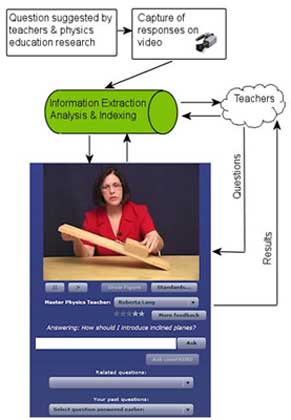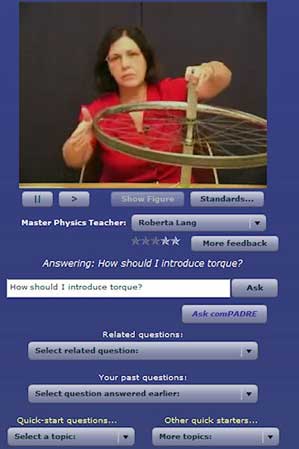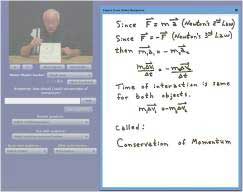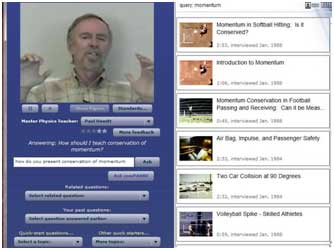Physics Teaching Web Advisory (Pathway): A Tool for 24-7 Pedagogical Assistance for Teachers of Physics
Dean Zollman
Often a physics teacher, particularly one who is new to teaching physics, just needs an experienced colleague to answer a question about teaching, a particular physics topic, or give advice on a good demonstration; maybe the teacher just needs a video clip to illustrate a concept. The Physics Teaching Web Advisory (Pathway) is a state-of-the-art, Web-based digital video database that is providing just this kind of assistance.

To create a Synthetic Interview we record on video a large number of responses to questions that teachers might ask. We then match each response to many variations of such questions. Using a sophisticated algorithm in which the order of words can be as important as the words themselves, we match our responses to the questions entered by the user.
Pathway is a growing digital library for physics teaching. More than a collection of materials, Pathway combines Carnegie Mellon University’s digital video library technology with pedagogical advances based on physics education research and with materials contributed by teachers. Pathway builds on a unique collaboration between several longstanding research projects in digital video libraries: advanced distance learning technologies, collaboration technologies and nationally known experts in physics pedagogy and high quality content.
Pathway’s primary target audience is teachers who are relatively new to the teaching of physics. They may have some physics background but have not studied the pedagogy of physics or the research on which that pedagogy is based. Because they are busy teachers, they frequently need information on a short time scale – perhaps for tomorrow’s class. They need pedagogical information quickly and at a time and place of their choosing; thus, a Web-based conversation with one or more experienced teachers could be a significant help.
Pathway’s software foundation is the Informedia Digital Video Library which has been developed at Carnegie Mellon University. It focuses specifically on information extraction from broadcast television video and audio content. It operates similarly to a Web search engine, but does so by searching on video and audio information. Unlike YouTube which searches only on keywords provided by the contributor, Informedia has automated the creation of a rich, indexed, searchable multimedia information resource through speech, image, and natural language processing. Using this state-of-the-art technology, we have created two components of Pathway -- a Synthetic Interview and collection of digital video learning materials.
Synthetic Interviews
An early popular Internet application was the chat room which has now been extended through applications such as Twitter and Instant/Text Messaging. During the infancy of the Internet, pundits predicted democratization of expertise and knowledge. Email and chat rooms would usher in this new age by providing a forum where anyone could ask any question of world-class experts. An error in this reasoning is that in any specialty, the number of experts is very small when compared to the general population. Experts do not scale, and cannot spend all their time answering questions.

Roberta Lang describes how she introduces torque.
A variation to convey information is a linear interview which can contain a surprising amount of knowledge. But simply watching such a presentation in which someone else is asking the questions is seldom an effective tool for transferring information, especially to someone who needs to know specific content “just-in-time.” The Synthetic Interview addresses the passive nature of the interview by creating an anthropomorphic interface into multimedia video data of a person responding to questions (interacting with another person). However, the responses of the interviewee are presented in such a way as to simulate the experience of the user interacting with the expert.
A conversation must enable the user to present the expert with questions as complete sentences, not a list of keywords. Processing of such open-ended user questions is a challenging task. However, it is a tractable task because full processing and “comprehension” of the input is not required. Instead, mapping to functional meaning categories with appropriate responses is sufficient. Synthetic Interview technology employs both structural and statistical processing algorithms to perform its categorization.
Using this technology, Pathway provides teachers a way to “converse” about the teaching of physics with four experienced physics teachers -- Paul G. Hewitt, a well-known author of both high school and college physics texts; Charles and Roberta Lang, two experienced and distinguished high school physics teachers; and Leroy Salary, an Associate Professor at Norfolk State University. Together they provide a wide range of experience and advice to the physics teacher.
The Pathway Synthetic Interview database has 6,687 questions, with more than 454,000 utterances (variations), and 20,158 unique question/answer pairs. 3,569 of the questions are directly associated with National Science Education Standards. Teachers pose a question and select the experienced teacher whom they wish to ask. The software matches the question to a recorded response and plays that response. The respondent is sometimes a talking head, but also can show demonstrations, graphs, charts and equations.

Charles Lang explains how he goes from Newton’s Laws to Conservation of Momentum. In keeping with the idea that he is having a conversation with the user, the equations are handwritten, as if he wrote them as he was talking.
Because many of the teachers are new to physics teaching, we recognized that they could need help determining what they need to ask. Thus, for each major topic, we have a list of “Quick Questions” which can be selected from a pull-down menu. Likewise, once a question has been asked, the teacher can obtain more information on the same topic by selecting from a list of “Related Questions.” With these questions or just by entering another question, the teacher can continue this virtual conversation with the experienced teacher, or decide that he or she wishes to hear another person’s view on the original question posed.
Digital Video Library
The Pathway Digital Video Library contains a large number of video clips that have been created during the past 20 years for physics instruction. The materials in the library are a database of video information which can be searched in somewhat standard ways. They are selected to satisfy a wide range of teaching needs, including demonstrations of physical phenomena, virtual labs, measurement from video scenes, and tips on the teaching of physics. Thus, they can provide background information, examples of teaching and video clips which can be used directly in class. The development of the library has lagged a little behind the Synthetic Interviews (and needed to be redesigned and re-thought in light of video sharing on the Web). The most recent version has just been deployed. When it is fully capable, the user will see the experienced teacher who is discussing the pedagogy of a topic on one side of the screen while thumbnails of videos related to that topic appear on the other side. A mock-up of how the user’s screen might appear is shown here.

A mock-up of how the screen will look when the Synthetic Interview and the Digital Video Library communicate via software. On the left Paul Hewitt discusses how to introduce conservation of momentum while on the right are video examples that can be used in class.
Evaluation
At this time, the evaluation of Pathway has primarily been a combination of Contextual Inquiry and Heuristic Evaluation at workshops and at professional meetings, feedback from individual users, and the beginnings of an analysis of the questions which teachers ask of the system. Users of the system continue to have very positive comments, especially noting the effectiveness of searches. Teachers who are relatively new to physics teaching have found the natural language “interviews” useful. Ongoing analysis of the questions posed by users shows that almost three-quarters of all questions relate to issues of physics pedagogy. This result indicates the inexperienced teacher is much more interested in and concerned about the methods of teaching rather than the physics subject matter.
Most of the development work on Pathway is nearing completion. If you find the concept interesting, you could help us in two ways:
- We are looking for teachers who would like to help us evaluate the project. Please send them our way. Or, if you night be able to use Pathway in a course or a teacher workshop, let us know.
- We wish to expand the video selections in the Digital Library. If you know of some appropriate videos, have made some yourself or seen some on YouTube, let us know.
My collaborators on Pathway are Brian Adrian, Sytil Murphy and Chris Nakamura at Kansas State University and Scott Stevens, Michael Christel and Bryan Maher at Carnegie-Mellon University. Pathway is supported by the National Science Foundation under grant numbers ESI-0455772 & ESI-0455813 with earlier proof of concept grants DUE-0226157, DUE-0226219.
To visit Pathway go to www.physicspathway.org. Question or comments can be sent to dzollman@phys.ksu.edu.
Dean Zollman is William and Joan Porter Professor and Head of the Department of Physics at Kansas State University.
Disclaimer - The articles and opinion pieces found in this issue of the APS Forum on Education Newsletter are not peer refereed and represent solely the views of the authors and not necessarily the views of APS.
